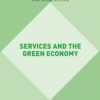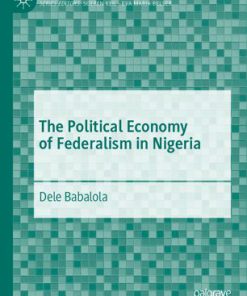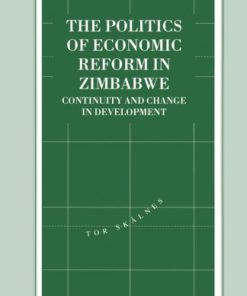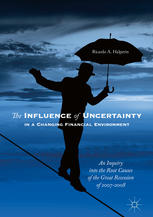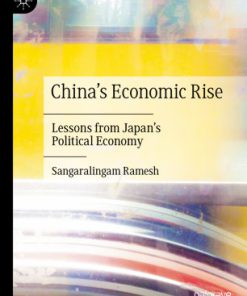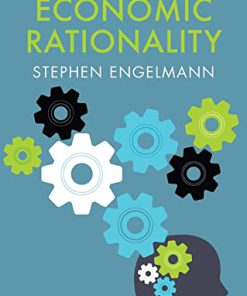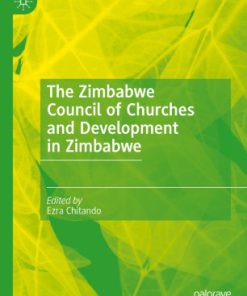Economic Management in a Hyperinflationary Environment 1st Edition by Raphael Otieno,George Kararach 9780191064708 019106470X
$50.00 Original price was: $50.00.$25.00Current price is: $25.00.
Economic Management in a Hyperinflationary Environment 1st Edition by Raphael Otieno,George Kararach – Ebook PDF Instant Download/Delivery:9780191064708,019106470X
Full download Economic Management in a Hyperinflationary Environment 1st Edition after payment

Product details:
ISBN 10:019106470X
ISBN 13:9780191064708
Author:Raphael Otieno,George Kararach
This volume provides an accessible and up-to-date account of the difficulties that the Zimbabwean economy and its population experienced during the crisis which peaked in 2008. It details the suffering and chaos that befell the country with dramatic socio-economic consequences on growth, macroeconomic stability, service delivery, livelihoods, and development. The volume seeks to provide a political economy analysis of leadership and economic management in developing economies based on Zimbabwe’s experience. It examines the triggers of the crisis, and the negative impact on productive sectors such as manufacturing and agriculture, social sectors such as education and health, and on financial services. The volume will be of interest to students of policy and economic management, as well as to government departments, central banks in developing countries, development agencies, donors, and NGOs.
Economic Management in a Hyperinflationary Environment 1st Table of contents:
Chapter 1: The Political Economy and Evolution of Development Policy in Zimbabwe
1.1 Background
1.2 From Rhodesia to Zimbabwe: Statism, Destabilization, and Racialist Political Economy
1.3 Evolution of Zimbabwe´s Macroeconomic Policies, 1980-2008
1.3.1 Pre-liberalization Period, 1980-90
1.3.2 The First Phase of the Economic Structural Adjustment Programme (1991-95)
Trade `Liberalization´
Domestic Deregulation
Financial Sector and Monetary Policy Reform
Fiscal Policy and Tax Reform
1.3.3 The Zimbabwe Programme for Economic and Social Transformation
1.3.4 Millennium Economic Recovery Programme
1.4 The Pursuit of Ineffective Macroeconomic Policies
1.5 Costly Political and Policy Decisions
1.6 Structure of the Book
References
Part I: Overview of the Crisis
Chapter 2: Pre-Crisis Macroeconomic Performance and Triggers of the Economic Crisis in Zimbabwe
2.1 Introduction
2.2 Zimbabwe´s Pre-crisis Macroeconomic Performance
2.2.1 Real Economic Growth
2.2.2 Fiscal Performance
2.2.3 Money Supply Growth
2.2.4 Inflation
2.2.5 Revenue Productivity of the Tax System
2.2.6 Total Debt
2.2.7 Exchange Rates
2.2.8 Balance of Payments and International Reserves
2.2.9 Employment
2.3 Literature Review on Determinants of Economic Growth
2.3.1 Indicators of Macroeconomic Uncertainty
2.3.2 Structural, Political, and Institutional Variables
2.4 Models to Explain Zimbabwe´s Economic Crisis
2.4.1 Regression Model
Initial GDP per capita
CPI inflation
Government consumption and budget deficit (per cent of GDP)
Savings ratio
M2/GDP (lagged)
Degree of openness
Rule of law
Dummy
2.4.2 Policy Index
2.4.3 Moderation Model
2.5 Presentation of Results
2.6 Discussion
2.6.1 Economic and Economic Policy Variables
2.6.2 Structural, Political, and Institutional Variables
Rule of law
Drought
2.7 Conclusions
References
Part II: Productive Sector Performance
Chapter 3: Response of the Manufacturing Sector to the Zimbabwe Economic Crisis
3.1 Introduction
3.2 Manufacturing Sector Growth under Economic Crises: A Literature Review
3.3 The Zimbabwe Manufacturing Sector before Hyperinflation
3.3.1 Policy Framework Governing the Sector
3.3.2 Some Performance Indicators before Hyperinflation
Manufacturing sector contribution to GDP
Level of production and wages
3.4 The Advent of Hyperinflation and Implications
3.4.1 Performance Indicators under Hyperinflation
3.4.2 Manufacturing Sector Contribution to GDP
3.4.3 Capacity Utilization
3.4.4 Manufacturing Value Added Per Head
3.4.5 Manufactured Exports
3.4.6 Manufacturing Sector Output Growth
3.5 Challenges Experienced by Manufacturers
3.5.1 Lack of Foreign Currency
3.5.2 Unavailability of Raw Materials
3.5.3 Weak Domestic Demand
3.5.4 Fuel Shortages
3.5.5 Unreliable Power
3.5.6 Working Capital Challenges
3.5.7 Price Controls
3.5.8 NRZ Operational Challenges
3.5.9 Labour Laws
3.5.10 Other Challenges
3.5.11 Survival Strategies by Companies
Decentralization
Compromising on quality
Developing syndicates
Payment terms
Toll manufacturing
3.6 Comparison with Other Countries that Faced Hyperinflation
3.6.1 Germany
3.6.2 Yugoslavia
3.6.3 Other Countries
3.7 Conclusion
References
Web References
Chapter 4: The Performance of the Tourism Sector in Zimbabwe during the 2000-08 Economic Crisis
4.1 Introduction
4.2 Literature Review
4.2.1 Importance of Tourism in Economic Development
4.2.2 Tourism under Economic Crisis
4.3 Performance of ZIMBABWE´S Tourism SECTOR during the Crisis Period
4.3.1 Performance of the Tourism Sector based on the Macroeconomic Variables
Arrivals and tourism receipt trends
An analysis of operations of the establishments in the tourism industry
4.3.2 Zimbabwe´s Tourism Competitiveness 2000-10
Accommodation
Accessibility
Road networks
Airlines connectivity
Rail networks
Attractions
Rebranding of the product
Amenities and activities
4.4 Measures Adopted to Counter the Crisis in the Sector
4.4.1 Tourism Development Zones
4.4.2 Regional Cooperation
4.4.3 Infrastructure Development
4.4.4 The Look East Policy
4.4.5 Image Building Thrust
4.4.6 The One-Stop Investment Initiative
4.4.7 The Relicensing of the Hospitality Sector
4.4.8 Role Played by the Private Sector
4.4.9 Quality
4.5 Lessons and Recommendations
4.5.1 Lessons Learnt
4.5.2 Recommendations
4.6 Conclusions
References
Chapter 5: Experiences in the Zimbabwe Hotel Industry during Hyperinflation
5.1 Introduction
5.2 The Tourism Sector in Zimbabwe
5.3 Literature Review
5.4 Methodology
5.4.1 Data Analysis Procedure
5.4.2 Findings
Demographics of respondents
Customers´ experiences of hotel services during the crisis
Responsiveness
Assurance
Tangibles
Empathy
Reliability
Calculating service quality experience using the Oliva and Sterman (2001) model
5.5 Hotels´ Efficiency
5.5.1 Types of Visitor
5.6 Conclusions
References
Chapter 6: The Impact of Hyperinflation on the Agriculture Sector: Lessons from Zimbabwe, 1998–200
6.1 Introduction
6.2 Developments in the Agriculture Sector
6.2.1 FastTrack Land Reform Programme
6.3 Literature Review on Inflation
6.4 Agriculture Production and Inflation Developments
6.4.1 Correlation Analysis
6.5 Methodology of Estimating the Impact of Inflation on the Agricultural Sector
6.6 Estimation Results
6.7 Conclusions
References
Part III: Banking, Capital Markets, and Financial Services
Chapter 7: Bank Failures in Zimbabwe: Evidence and Lessons, 2000–09
7.1 Introduction
7.2 Literature Review
7.2.1 Empirical Studies on Bank Failures during the 2008 Global Financial Crisis
7.2.2 Empirical Studies in Developing Countries
7.3 Methodology
7.3.1 Impact of Macroeconomic Variables: GDP Growth
Impact of Macroeconomic Variables: Inflation and Interest Rates
Impact of Macroeconomic Variables: Balance of Payments
7.3.2 The Impact of Bank Fundamentals
Capital Adequacy
Asset quality
Management
Earnings
Liquidity
7.4 Conclusions
References
Chapter 8: Operations, Regulation, and Practices of the Zimbabwe Stock Exchange during the Hyperinfl
8.1 Introduction
8.2 Literature on the Role of Stock Markets
8.2.1 Stock Market Theories and ZSE Performance during Hyperinflation
8.3 History and Developments in the ZSE
8.3.1 Background
8.3.2 Management and Regulation of the ZSE during Hyper-inflation
8.3.3 ZSE Trading and Settlement Systems during Hyperinflation
8.3.4 ZSE Transaction Costs during Hyperinflation
8.3.5 State of Economic Conditions that the ZSE Operated Under during Hyperinflation
8.3.6 Regional Position of the ZSE during Hyperinflation
8.3.7 Why the ZSE Was Preferred by Investors during Hyperinflation
8.3.8 ZSE and Foreign Participation during Hyperinflation
Hyperinflation eroded proceeds
8.4 ZSE Performance
8.4.1 ZSE New Listings Drought Under Hyperinflation
8.4.2 ZSE Foreign Participation Rules
8.4.3 Popularity of Dually Listed Companies during Hyperinflation
8.4.4 Fund Raising by Listed Companies at the ZSE
8.4.5 ZSE Market Performance during Hyperinflation
8.4.6 ZSE Asset Price Bubble and How it Burst during Hyperinflation
8.4.7 ZSE Activity versus Excessive Monetary Growth and Hyperinflation
8.4.8 ZSE Stocks versus Fixed Income Assets
8.4.9 Investor Profile Shift during Hyperinflation
8.4.10 Share Pricing and Arbitrage Opportunities
8.4.11 ZSE Trading and Illegal Parallel Market for Foreign Exchange
8.4.12 RBZ Policy Response to the ZSE Rally during Hyperinflation
8.5 Conclusion
References
Chapter 9: Stock Market Returns and Hyperinflation in Zimbabwe, 1998-2008
9.1 Introduction
9.2 Literature Review
9.3 Methodology and Empirical Model
9.3.1 Data and Empirical Results
9.3.2 Main Empirical Results
9.3.3 Co-integration Test Results
9.4 Conclusion
References
Chapter 10: The Pension Fund Industry Experiences during Hyperinflation
10.1 Introduction
10.2 The Social Security Concept
10.2.1 Retirement Savings Model
10.2.2 State pension in Zimbabwe
10.2.3 Occupational Pension Schemes
10.2.4 Life Assurance and Savings Policies
10.3 Pension Fund Industry Stakeholders and their Roles
10.3.1 Government
The Insurance and Pensions Commission (IPEC)
10.3.2 Zimbabwe Association of Pension Funds (ZAPF)
10.3.3 Participating Employers
10.3.4 Contributing Members
10.3.5 Pensioners Receiving Pension in Payments
10.3.6 Trustees
10.3.7 Pension Fund Administrators
10.3.8 Asset Managers
10.3.9 Life Insurers
10.3.10 Other Service Providers
10.4 Pension Scheme Design
10.4.1 Defined Benefit Schemes
10.4.2 Defined Contribution Fund
10.5 Research Methodology
10.5.1 Research Design, Sampling, and Study Population
10.5.2 Sample Size and Sampling Techniques
10.5.3 Data Gathering Tools and Administration
10.6 The Impact of Hyperinflation on Pension Funds
10.6.1 Economic Environment in Zimbabwe
10.6.2 Impact on the Objectives of a Contributory Occupational Private Pension Fund
10.6.3 Effect of Hyperinflation on Pension Fund Operations
Variations to Pensionable Salary and Contributions
10.6.4 Reduction in Membership
10.6.5 Payment of Benefits
10.6.6 Impact on Pension Fund Industry Operations
10.6.7 Effect of Hyperinflation on Pension Fund Investments
Pension fund investment products
Impact of Regulation on Pension Fund Investments during Hyperinflation
Impact of Hyperinflation on Equities
Impact of Hyperinflation on Property
Impact on Government (Prescribed Assets), Corporate Bonds, Money Market, Cash, and Cash Equivalents
10.6.8 Impact on Scheme Design
Defined Benefit (DB)
Defined Contribution (DC)
10.7 The Dollarization Experience
10.7.1 Valuation of Assets
10.7.2 The Conversion Process
10.7.3 Low Values on Conversion
10.7.4 Actuarial Valuation Deficits in Hard Currency and Suboptimal Replacement Ratios
10.7.5 Suboptimal Pension Savings
10.8 Challenges Experienced Post the Conversion Process
10.8.1 Absence of Guidelines
10.8.2 Low Conversion Values
10.8.3 Industry Public Opinion Challenges
10.8.4 Outstanding Benefit Payments
10.8.5 Product Failure
10.8.6 Lack of Confidence in Pension Funds in Zimbabwe as a Retirement Saving Plan
10.9 Measures Being Taken to Address Post Conversion Challenges
10.9.1 Review of the Conversion Process
10.9.2 Review of the Investment Regulations
10.9.3 Pension Enhancements
10.9.4 Public Awareness Campaigns
10.10 Lessons Drawn
10.10.1 Investments
10.10.2 Currency Changes and Conversion of Values
10.10.3 Tax on Pension Enhancements
10.10.4 Development of Relevant New Products
10.10.5 Member Education
10.11 Conclusion
References
Part IV: Monetary Policy and Public Financial Management
Chapter 11: Zimbabwe Monetary Policy, 1998-2012: From Hyperinflation to Dollarization
11.1 Introduction
11.2 Hyperinflation in Historical Perspective
11.3 Background to the Zimbabwe Hyperinflation
Appeasing the War Veterans
The Congo War
Land Reform
Political Challenge
Winners and Losers from Inflation
11.4 The Inflation-Devaluation Spiral
Foreign Exchange Markets
Tests of Purchasing Power Parity (PPP)
Causality
11.5 The Impossible Trinity Hypothesis
11.6 The Dollarization Exit Strategy
11.7 Choice of Exchange Regime
Optimal Currency Area Policy
SADC Regional Integration and the CMA
11.8 Challenges of Dollarization
Balance of Payments
Monetary Management
Investment
11.9 Conclusions
References
Chapter 12: Relegating the Core Business: The Case of the Reserve Bank of Zimbabwe Undertaking Quasi
12.1 Introduction
12.2 Quasi-Fiscal Activities (QFAs): A Literature Review
12.3 Quasi-Fiscal Activities of RBZ: A History
12.3.1 Troubled Bank Fund
12.3.2 Productive Sector Facility
12.3.3 Basic Commodities Supply Side Intervention (BACOSSI)
12.3.4 Support to Health
12.4 Macroeconomic Impact of the Quasi-fiscal Activities
12.4.1 Increase in Inflation and Money Supply
12.4.2 RBZ Debt Ballooning
12.4.3 Dollarization
12.5 Conclusion
References
Chapter 13: Management of Public Debt in Zimbabwe During the Hyperinflationary Period
13.1 Introduction
13.2 Literature Review
13.2.1 Empirical Literature Review
13.3 Institutional and Regulatory Framework for Public Debt Management
13.3.1 The Institutional Framework
Domestic debt
External debt
13.3.2 Legal Framework for Public Debt Management
Domestic debt management
External debt
13.4 Evolution of Domestic Debt 2000-08
13.4.1 Domestic Debt Instruments
13.4.2 Domestic Debt Portfolio 2000-09
13.4.3 Evolution of Domestic Debt by Holder
13.5 Evolution of External Debt 2000-08
13.5.1 Evolution of External Debt
13.5.2 External Debt by Currency Composition
13.5.3 Public External Debt Average Loan Terms
13.5.4 External Debt Sustainability
13.5.5 Implications of the Debt and Arrears
13.5.6 Sustainable Measures to Resolving the Debt Problem
13.7 Major Challenges with the Public Debt Management
13.7.1 Summary of Key Lessons
13.7.2 Recommendations
13.8 Conclusion
References
Chapter 14: Monetary Policy Formulation and Implementation in a Hyperinflationary Environment: The C
14.1 Introduction
14.1.1 Zimbabwe´s Economic Developments
14.2 Literature Review
14.2.1 Definitions
Neutrality of Money
Price Stability
Hyperinflation
Quasi-fiscal Activities/Operations (QFAs/QFOs)
Monetary Policy
Central bank Independence and Quasi-fiscal Activities
14.2.2 Theoretical Evidence
Monetarist Theory (Monetarism)
Quantity Theory of Money
14.2.3 Empirical Literature
Long Run Neutrality of Money
High Inflation Episodes in Twenty-Four Selected Countries
14.2.4 Implications of Quasi-fiscal Activities
The Eastern European Cases
The European Union (EU) Experience
Quasi-fiscal Operations in Zimbabwe, 2004-08
14.2.5 Monetary Formulation and Implementation during Economic Crisis
Monetary Policy during the Recession of 2007-09: USA
Turkey
Angola
Mitigatory Measures
14.2.6 Lessons from international experience for Zimbabwe
Lessons from Japan´s Experiences in Economic Crisis
14.3 Research Methodology
14.3.1 Data Description
14.3.2 Empirical Data Analysis and Discussion of Results
Series Plots
Descriptive Statistics
Unit Root Test
Cointegration Tests
Residual Testing
14.4 Estimating the Price Level Equation
14.4.1 Residual Testing
14.4.2 Normality Tests of Residuals
14.4.3 Estimation of an Error Correction Model (ECM)
14.4.4 Wald Coefficient Test
14.4.5 Granger Causality Tests
14.5 Secondary Data Results and Analysis
14.5.1 Agricultural Sector Facilities
14.6 Policy Recommendations
14.6.1 Implications for Future Research
14.7 Conclusion
APPENDIX 14.1
(a) History of Reserve Bank of Zimbabwe Governors
(b) Series Plots of LM2, LCPIE, LGDP (2000Q1 2008Q2)
(c) Normality Tests of Variables
APPENDIX 14.2
(a) Zimbabwe—Key economic indicators, 2001–2009
(b) Fiscal Balance Including RBZ Quasi-fiscal Losses
(c) Zimbabwe maize production, 1994-2009
(d) Zimbabwe-Wheat production trends from 1996-2008, and forecast for 2009
(e) Zimbabwe-Cotton and tobacco production trends, 2000-2009
(f) Maize Production, Area Planted and Yield Trends
(g) Cotton Production, Area Planted and Yield Trends
(h) Soya Bean Production Trends
References
Part V: Social Dimensions of the Crisis
Chapter 15: The Impact of Human Capital Losses in Zimbabwe: A Focus on the Public Sector for the Cri
15.1 Introduction
15.2 The Brain Drain Problem
15.2.1 Background to Migration and Human Capital Losses in Zimbabwe
15.3 Zimbabwe´s Position on Labour Migration
15.3.1 The Migration Policy Framework for Africa
15.3.2 SADC Protocol on the Facilitation of Movement of Persons
15.3.3 Zimbabwe´s Labour Migration Policy Framework
15.4 Impact of Human Capital Losses in Zimbabwe
15.4.1 Impact on the Primary and Secondary Education Sector
15.4.2 Impact on Higher Education
15.4.3 Impact on Health
Health Worker Vacancy Trends
Vacancy Rates at the Medical Schools
Towards Health Worker Retention in Zimbabwe
15.4.4 Impact on the Productive Sectors
Impact on Agriculture
Impact on the Engineering Sector
15.5 The Positive Face of Human Capital Losses-Diaspora Participation in Development
15.6 Conclusion
References
Chapter 16: The Social Protection Policy Responses in the Primary and Secondary Education Sector dur
16.1 Introduction
16.2 Literature Review
16.3 GOVERNMENT OF ZIMBABWE´S Social Protection Policy Response in the Education Sector during Econ
16.3.1 The Impact of the Crisis on Zimbabwe´s Education Sector
Net Enrolment Rate for Primary Education
Primary School Dropout Rate
Primary School Completion Rate
Quality of Education
Pass Rates for Primary and Secondary Schools
Pupil to Text Book Ratio Primary Schools
Teacher to Pupil Ratio and Literacy Rates
16.3.2 Teacher Qualification and Competency
16.3.3 Supervision of Service Delivery in the Education Sector
16.3.4 Dilapidated Infrastructure at Schools
16.3.5 Investment in Education
16.3.6 Coping with the Effects of the Economic Crisis
16.4 Historical Background to Social Protection in the Education Sector
16.5 Social Protection Response to the Crisis through the BEAM Programme
16.5.1 Implementation of the BEAM Programme
16.5.2 Target Group
16.6 Policy Analysis of the BEAM Programme
16.6.1 Social Equality
16.6.2 Economic Viability
16.6.3 Administrative Viability
16.6.4 Impact
16.6.5 Sustainability
16.7 Lessons Learnt from the Implementation of the BEAM Programme
16.8 Policy Recommendations
16.8.1 Funding
16.8.2 Feeding Schemes
16.8.3 Crafting a Comprehensive National Social Protection Policy
16.9 Conclusions
References
Chapter 17: The Health Sector´s Response to the Impact of Hyperinflation: The Case of Zimbabwe: The
17.1 Introduction
17.2 The Impact of Hyperinflation on Health Sector in Zimbabwe
17.2.1 Human Capita Drain
17.2.2 Declines in Total Health Expenditure
17.2.3 Decline of Health Expenditure Per Capita; Health Expenditure Per Capita via Public Health Fun
17.2.4 Decline in Human Resources Expenditure for Health
17.2.5 Percentage of Public Health Budget Expended
17.2.6 Deterioration of Health Facility Infrastructure
17.3 Coping with Inflation in Zimbabwe
17.3.1 Staff Retention Strategies
17.3.2 Bonding of Specialized and Critical New Staff
17.3.3 Suspension of Private and Locum Work
17.3.4 Use of Strict Monitoring
17.3.5 Introduction of Results-based Management System
17.3.6 Internal Capacity Building
17.3.7 Self-Financing of Medical Services
17.3.8 Duty Exemption for Vehicle Imports
17.3.9 Donor-Ministry of Health Partnership
17.3.10 The Harmonized Human Resources Retention Scheme
17.4 Conclusion
References
Chapter 18: Social Challenges of Hyperinflation: A Case of Health and Education in Zimbabwe, 2000-08
18.1 Introduction
18.2 Literature Review
18.3 Education and Health Delivery System Performance during the Crisis Period
18.3.1 Health Sector
18.3.2 Brain Drain
18.3.3 Health Service Delivery Indicators
18.3.4 Mortality Rates
18.3.5 HIV and AIDS Prevalence and Deaths
18.3.6 Tuberculosis
18.3.7 Cholera
18.3.8 Health Financing
18.3.9 Government Intervention Mechanisms (Social Safety Nets)
18.3.10 Health Assistance Programme
18.3.11 Public Assistance Programme
18.4 Education Delivery
18.4.1 Brain Drain
18.4.2 Education Programme during Hyperinflation Period
18.4.3 Funding in the Educational Sector
18.4.4 Social Safety Nets in the Education Sector: Basic Education Assistance Module (BEAM)
18.5 Lessons Learnt
18.6 Conclusion
References
Chapter 19: Health Care Finance and Health Outcomes during Zimbabwe´s Economic Crisis
19.1 Introduction
19.2 The Industrial Organization of Health Systems
19.2.1 The Poverty-Health Finance-Health Outcome Nexus
19.3 Zimbabwe´s Health Sector and the Crisis in Perspective
19.4 Research Methods
19.4.1 Crisis Impact Assessment
Health care financing
The Health Sector Delivery Capacity
Health Outcomes
Life Expectancy at Birth
Maternal Mortality
Child Health
Disease Prevalence
HIV/AIDS
Tuberculosis
Cholera
Mental Health
Preventive Health
Increased Inequity in the Health Sector
19.4.2 The t-Test Analysis
19.5 Conclusion
References
Part VI: Concluding Remarks
Chapter 20: Development Policy and Managing Shocks in Developing Countries: Lessons on Currency Refo
20.1 Introduction
20.2 Description of the Most Recent Situation
20.2.1 The GPA-related Outcomes
20.2.2 STERP Outcomes
20.2.3 Constitutional Reforms and the 2013 Elections
20.3 Political Economy and the Evolution of Events up to Currency Reforms
20.3.1 Currency Devaluation and Other Monetary Reforms
20.3.2 Investment Climate
20.3.3 Productive Capacity, Export Performance, and Formal Employment
20.3.4 Development Co-operation and Donor Assistance
20.3.5 Summarizing the Lethal Cocktail
20.4 Some Conditions Necessary for Successful Currency Reforms
20.5 Post Currency-reform Economic Performance and Political Dynamics
20.6 Concluding Remarks
People also search for Economic Management in a Hyperinflationary Environment 1st:
what is economic management
economic management examples
the economic management in a hyperinflationary environment
economic hyperinflation
hyperinflation in economics definition
Tags:
Raphael Otieno,George Kararach,Economic,Hyperinflationary,Environment
You may also like…
Politics & Philosophy - Social Sciences
Politics & Philosophy - Social Sciences
Politics & Philosophy - Government & Politics
Politics & Philosophy
Business & Economics
Politics & Philosophy - Government & Politics
Cookbooks
Business & Economics - Economics
History - World History
The Zimbabwe Council of Churches and Development in Zimbabwe Ezra Chitando



